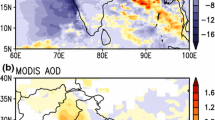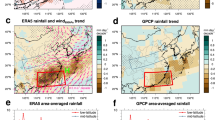Abstract
The WRF Model is used to investigate intraseasonal responses of the summer rainfall to aerosol direct and cloud-adjustment effects over East Asia, where the anthropogenic aerosol loading has been increasing in the past few decades. The responses are evaluated by comparing two cases for each year during 2002–2008: a control case imposing the observed aerosol optical depth of the corresponding year and a sensitivity case having anthropogenic components of the control case reduced by 75%. Analyses of multiple-year simulations reveal that aerosol-induced changes of rainfall and circulation exhibit strong intraseasonal variability, and that the spatial pattern of changes in the monthly rainfall is related to the intensification and westward extension of the western North-Pacific subtropical high (WNPSH) by increased aerosols. This perturbation of the WNPSH induces surface air divergence over the southeast China and convergence over regions to the north and west of the WNPSH, causing, respectively, decreased and increased rainfall. As the WNPSH migration path varies year by year, however, the variability of rainfall changes over subregions of the eastern China (e.g., North China) is large within the decade. Meanwhile, the pattern of summer-gross rainfall changes also shows large interannual variation, but the general pattern of wetter in the west and dryer in the east persists. Results also suggest that the aerosol increase tends to reduce the number of Tibet Plateau vortices, which indirectly influence summer rainfall over the eastern China.


Source of SO2 emission rate: EC-JRC/PBL. EDGAR version 4.2. http://edgar.jrc.ec.europa.eu/, 2011









Similar content being viewed by others
References
Albrecht BA (1989) Aerosols, cloud microphysics, and fractional cloudiness. Science 245:1227–1230. doi:10.1126/science.245.4923.1227
Bordoni S, Schneider T (2008) Monsoons as eddy-mediated regime transitions of the tropical overturning circulation. Nat Geosci 1:515–519. doi:10.1038/ngeo248.
Chang C-P, Zhang Y, Li T (2000) Interannual and interdecadal variations of the East Asian summer monsoon and tropical Pacific SSTs. Part I: roles of the subtropical ridge. J Climate 13:4310–4325. doi:10.1175/1520-0442(2000)013<4310:IAIVOT>2.0.CO;2
Chen F, Dudhia J (2001) Coupling an advanced land surface–hydrology model with the Penn State–NCAR MM5 modeling system. Part I: model implementation and sensitivity. Mon Weather Rev 129:569–585. doi:10.1175/1520-0493(2001)129<0569:caalsh>2.0.co;2
Chen J-P, Liu S-T (2004) Physically based two-moment bulkwater parametrization for warm-cloud microphysics. Q J Roy Meteor Soc 130:51–78. doi:10.1256/Qj.03.41
Chen G, Wang W-C (2016) Aerosol–stratocumulus–radiation interactions over the southeast Pacific: implications to the underlying air–sea coupling. J Atmos Sci 73:2759–2771. doi:10.1175/JAS-D-15-0277.1
Chen G, Wang W-C, Chen J-P (2015) Aerosol–stratocumulus–radiation interactions over the southeast Pacific. J Atmos Sci 72:2612–2621. doi:10.1175/jas-d-14-0319.1
Cheng C-T, Wang W-C, Chen J-P (2007) A modelling study of aerosol impacts on cloud microphysics and radiative properties. Q J Roy Meteor Soc 133:283–297. doi:10.1002/Qj.25
Cheng C-T, Wang W-C, Chen J-P (2010) Simulation of the effects of increasing cloud condensation nuclei on mixed-phase clouds and precipitation of a front system. Atmos Res 96:461–476. doi:10.1016/j.atmosres.2010.02.005
Dao S-Y, Chen L-S (1957) The structure of general circulation over continent of Asia in summer. J Meteorol Soc Japan Ser II(35A):215–229
Dee DP et al (2011) The ERA-Interim reanalysis: configuration and performance of the data assimilation system. Q J Roy Meteor Soc 137:553–597. doi:10.1002/qj.828
Fan J et al (2012) Aerosol impacts on clouds and precipitation in eastern China: Results from bin and bulk microphysics. J Geophys Res Atmos 117:D00K36. doi:10.1029/2011jd016537
Fan J, Wang Y, Rosenfeld D, Liu X (2016) Review of aerosol–cloud interactions: mechanisms, significance, and challenges. J Atmos Sci 73:4221–4252. doi:10.1175/jas-d-16-0037.1
Feng Y, Zhao X (2015) Changes in spatiotemporal pattern of precipitation over China during 1980–2012. Environ Earth Sci 73:1649–1662. doi:10.1007/s12665-014-3517-x.
Guo L, Highwood EJ, Shaffrey LC, Turner AG (2013) The effect of regional changes in anthropogenic aerosols on rainfall of the East Asian Summer Monsoon. Atmos Chem Phys 13:1521–1534. doi:10.5194/acp-13-1521-2013
Hong S-Y, Noh Y, Dudhia J (2006) A new vertical diffusion package with an explicit treatment of entrainment processes. Mon Weather Rev 134:2318–2341. doi:10.1175/mwr3199.1
Hong C-C, Lee M-Y, Hsu H-H, Kuo J-L (2010) Role of submonthly disturbance and 40–50 day ISO on the extreme rainfall event associated with Typhoon Morakot (2009) in Southern Taiwan. Geophys Res Lett 37:L08805. doi:10.1029/2010gl042761
Huffman GJ et al (2001) Global precipitation at one-degree daily resolution from multisatellite observations. J Hydrometeorol 2:36–50. doi:10.1175/1525-7541(2001)002<0036:gpaodd>2.0.co;2
Iacono MJ, Delamere JS, Mlawer EJ, Shephard MW, Clough SA, Collins WD (2008) Radiative forcing by long-lived greenhouse gases: Calculations with the AER radiative transfer models. J Geophys Res Atmos. doi:10.1029/2008JD009944.
Kain JS (2004) The Kain–Fritsch convective parameterization: an update. J Appl Meteorol 43:170–181. doi:10.1175/1520-0450(2004)043<0170:tkcpau>2.0.co;2
Lamarque JF et al (2012) CAM-chem: description and evaluation of interactive atmospheric chemistry in the Community Earth System Model. Geosci Model Dev 5:369–411. doi:10.5194/gmd-5-369-2012
Lau KM, Kim KM (2006) Observational relationships between aerosol and Asian monsoon rainfall, and circulation. Geophys Res Lett 33:L21810. doi:10.1029/2006gl027546
Lau KM, Kim MK, Kim KM (2006) Asian summer monsoon anomalies induced by aerosol direct forcing: the role of the Tibetan Plateau. Clim Dynam 26:855–864. doi:10.1007/s00382-006-0114-z
Li Z, Niu F, Fan J, Liu Y, Rosenfeld D, Ding Y (2011a) Long-term impacts of aerosols on the vertical development of clouds and precipitation. Nat Geosci 4:888–894. doi:10.1038/Ngeo1313.
Li Z et al (2011b) East Asian studies of tropospheric aerosols and their impact on regional climate (EAST-AIRC): an overview. Journal of Geophysical Research: Atmospheres 116:D00K34. doi:10.1029/2010jd015257
Li S et al (2016a) Impact of aerosols on regional climate in southern and northern China during strong/weak East Asian summer monsoon years. J Geophys Res Atmos. doi:10.1002/2015jd023892
Li Z et al (2016b) Aerosol and monsoon climate interactions over Asia. Rev Geophys. doi:10.1002/2015rg000500.
Lin Z (2015) Analysis of Tibetan Plateau vortex activities using ERA-Interim data for the period 1979–2013. J Meteorol Res 29:720–734. doi:10.1007/s13351-015-4273-x
Liu H, Yang J, Zhang D-L, Wang B (2014) Roles of synoptic to quasi-biweekly disturbances in generating the summer 2003 heavy rainfall in East China. Mon Weather Rev 142:886–904. doi:10.1175/MWR-D-13-00055.1
Manoj MG, Devara PCS, Safai PD, Goswami BN (2011) Absorbing aerosols facilitate transition of Indian monsoon breaks to active spells. Clim Dynam 37:2181–2198. doi:10.1007/s00382-010-0971-3
Monin AS, Obukhov AM (1954) Basic laws of turbulent mixing in the surface layer of the atmosphere. Contrib Geophys Inst Slovak Acad Sci 24:163–187
Park H-S, Lintner BR, Boos WR, Seo K-H (2015) The effect of midlatitude transient eddies on monsoonal southerlies over Eastern China. J Climate 28:8450–8465. doi:10.1175/jcli-d-15-0133.1
Qian W, Lee DK (2000) Seasonal march of Asian summer monsoon. Int J Climatol 20:1371–1386. doi:10.1002/1097-0088(200009)20:11<1371::AID-JOC538>3.0.CO;2-V
Ramanathan V, Crutzen PJ, Kiehl JT, Rosenfeld D (2001) Atmosphere—Aerosols, climate, and the hydrological cycle. Science 294:2119–2124. doi:10.1126/science.1064034
Ren X, Yang X, Sun X (2013) Zonal oscillation of western Pacific subtropical high and subseasonal SST variations during Yangtze persistent heavy rainfall events. J Climate 26:8929–8946. doi:10.1175/JCLI-D-12-00861.1
Rosenfeld D et al (2008) Flood or drought: How do aerosols affect precipitation? Science 321:1309–1313. doi:10.1126/science.1160606
Roundy PE (2012) Tropical–extratropical interactions. In: Lau WKM, Waliser DE (eds) Intraseasonal variability in the atmosphere-ocean climate system. second edn. Springer, Berlin, pp 497–512. doi:10.1007/978-3-642-13914-7_14
Schneider T, Bordoni S (2008) Eddy-mediated regime transitions in the seasonal cycle of a Hadley circulation and implications for monsoon dynamics. J Atmos Sci 65:915–934. doi:10.1175/2007jas2415.1
Stevens B, Feingold G (2009) Untangling aerosol effects on clouds and precipitation in a buffered system. Nature 461:607–613. doi:10.1038/nature08281
Tao S-y, Ding Y-h (1981) Observational evidence of the influence of the Qinghai-Xizang (Tibet) Plateau on the Occurrence of heavy rain and severe convective storms in China. Bull Amer Meteorol Soc 62:23–30. doi:10.1175/1520-0477(1981)062<0023:oeotio>2.0.co;2
Thiébaux J, Rogers E, Wang W, Katz B (2003) A new high-resolution blended real-time global sea surface temperature analysis. Bull Amer Meteorol Soc 84:645–656. doi:10.1175/BAMS-84-5-645
Thompson G, Tewari M, Ikeda K, Tessendorf S, Weeks C, Otkin J, Kong F (2016) Explicitly-coupled cloud physics and radiation parameterizations and subsequent evaluation in WRF high-resolution convective forecasts. Atmos Res 168:92–104. doi:10.1016/j.atmosres.2015.09.005
Twomey S (1974) Pollution and planetary albedo. Atmos Environ 8:1251–1256. doi:10.1016/0004-6981(74)90004-3
Wang M, Duan A (2015) Quasi-biweekly oscillation over the Tibetan Plateau and its link with the Asian summer monsoon. J Climate 28:4921–4940. doi:10.1175/jcli-d-14-00658.1
Wang B, Xiang B, Lee J-Y (2013a) Subtropical High predictability establishes a promising way for monsoon and tropical storm predictions. Proc Natl Acad Sci 110:2718–2722. doi:10.1073/pnas.1214626110
Wang Y, Khalizov A, Levy M, Zhang RY (2013b) New directions: Light absorbing aerosols and their atmospheric impacts. Atmos Environ 81:713–715. doi:10.1016/j.atmosenv.2013.09.034
Wang Y et al (2014) Assessing the effects of anthropogenic aerosols on Pacific storm track using a multiscale global climate model. Proc Natl Acad Sci 111:6894–6899. doi:10.1073/pnas.1403364111
Wang Y, Jiang J, Su H (2015) Atmospheric responses to the redistribution of anthropogenic aerosols. J Geophys Res Atmos. doi:10.1002/2015jd023665
Yang J, Wang B, Bao Q (2010) Biweekly and 21-30-day variations of the subtropical summer monsoon rainfall over the lower reach of the Yangtze River Basin. J Climate 23:1146–1159. doi:10.1175/2009JCLI3005.1
Yang X, Ferrat M, Li Z (2013a) New evidence of orographic precipitation suppression by aerosols in central China. Meteorol Atmos Phys 119:17–29. doi:10.1007/s00703-012-0221-9
Yang X, Yao Z, Li Z, Fan T (2013b) Heavy air pollution suppresses summer thunderstorms in central China. J Atmos Sol-Terr Phy 95–96:28–40. doi:10.1016/j.jastp.2012.12.023
Yang J, Bao Q, Wang B, Gong D, He H, Gao M (2014) Distinct quasi-biweekly features of the subtropical East Asian monsoon during early and late summers. Clim Dynam 42:1469–1486. doi:10.1007/s00382-013-1728-6
Yang J, Bao Q, Wang B, He H, Gao M, Gong D (2016) Characterizing two types of transient intraseasonal oscillations in the Eastern Tibetan Plateau summer rainfall. Clim Dynam. doi:10.1007/s00382-016-3170-z
Zhai P, Zhang X, Wan H, Pan X (2005) Trends in total precipitation and frequency of daily precipitation extremes over China. J Climate 18:1096–1108. doi:10.1175/JCLI-3318.1
Zhang P, Li G, Fu X, Liu Y, Li L (2014) Clustering of Tibetan Plateau vortices by 10–30-Day intraseasonal oscillation. Mon Weather Rev 142:290–300. doi:10.1175/mwr-d-13-00137.1
Acknowledgements
The authors thank the two anonymous reviewers for valuable suggestions and comments, which greatly help clarify this study. This study is supported by a grant from the Office of Sciences (BER), U.S. DOE. JY acknowledges the supports by funds from National Natural Science Foundation of China (Grant 41375003 and Grant 41621061), and WCW acknowledges the supports of Chinese 973 program (Grant 2013CB955803) to visit Beijing University and the Institute of Atmospheric Physics.
Author information
Authors and Affiliations
Corresponding author
Additional information
This paper is a contribution to the special issue on East Asian Climate under Global Warming: Understanding and Projection, consisting of papers from the East Asian Climate (EAC) community and the 13th EAC International Workshop in Beijing, China on 24–25 March 2016, and coordinated by Jianping Li, Huang-Hsiung Hsu, Wei-Chyung Wang, Kyung-Ja Ha, Tim Li, and Akio Kitoh.
Rights and permissions
About this article
Cite this article
Chen, G., Yang, J., Bao, Q. et al. Intraseasonal responses of the East Asia summer rainfall to anthropogenic aerosol climate forcing. Clim Dyn 51, 3985–3998 (2018). https://doi.org/10.1007/s00382-017-3691-0
Received:
Accepted:
Published:
Issue Date:
DOI: https://doi.org/10.1007/s00382-017-3691-0




